Seattle has one of the most famous skylines in the United States, so it’s not surprising that the city also is full of famous buildings. Some are skyscrapers, but others are buildings whose impressiveness barely rises above the street level.
Let’s count down the 15 most famous buildings in Seattle. From tall buildings, to iconic landmarks, to gothic treasures, there’s something for everyone on this list!
The 15 Most Famous Buildings in Seattle
- Space Needle
- Seattle Central Library
- Rainier Tower
- Smith Tower
- Starbucks Center
- Columbia Center
- Climate Pledge Arena
- The Amazon Spheres
- MoPOP
- Suzzallo Library
- Husky Stadium
- Safeco Plaza
- King Street Station
- F5 Tower
- St. James Cathedral
1. Space Needle
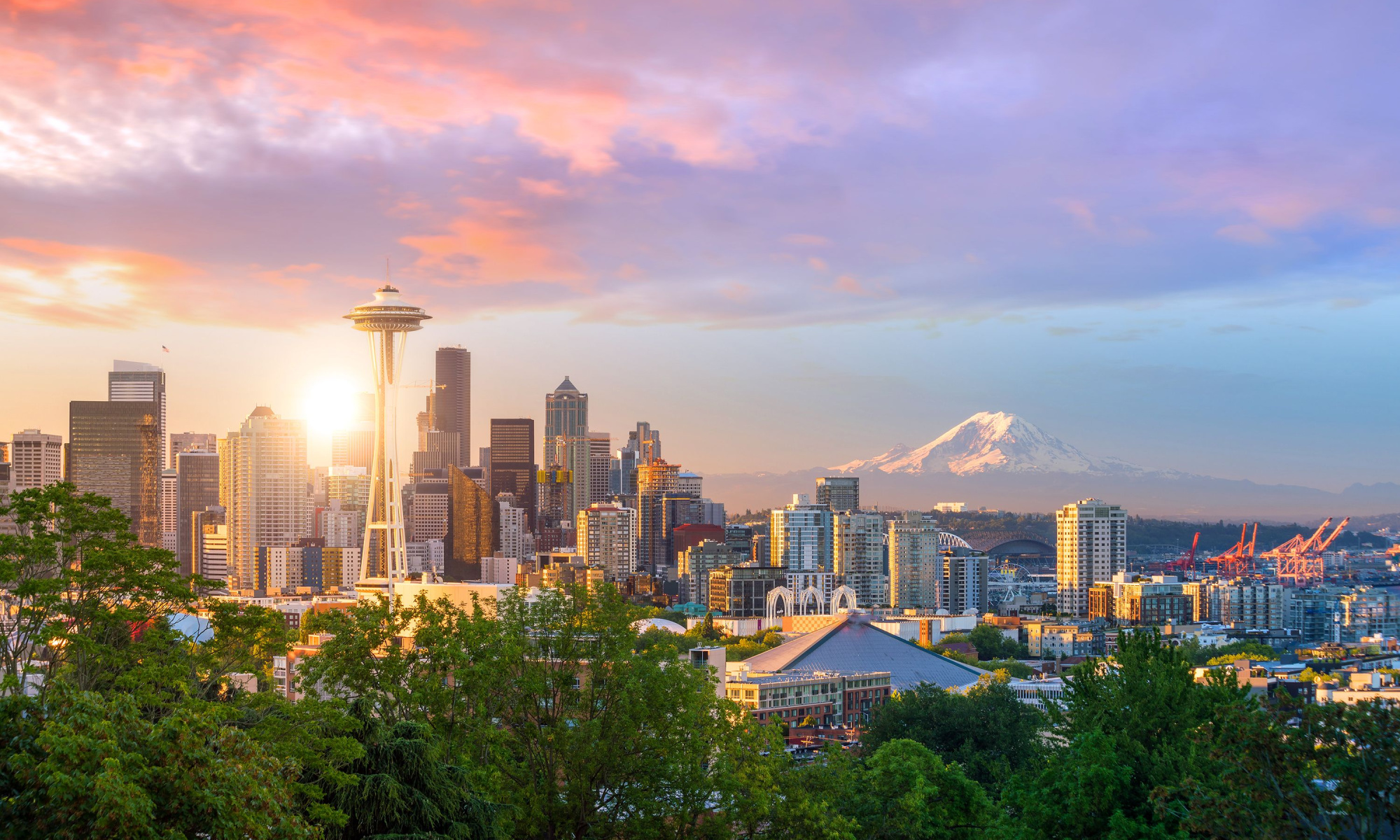
- Height: 605 feet tall
- Floors: N/A
- Square footage: N/A
Any list of the most famous buildings in Seattle needs to begin with the Space Needle. The Space Needle is often photographed from Kerry Park, which creates the optical illusion that it’s the tallest building in Seattle (see picture above!). However, it stands at “just” 605 feet, which is more than 300 feet shorter than Seattle’s tallest building.

The Space Needle was created for the 1962 World Fair, which focused on technological progress. It quickly became a symbol for Seattle itself. Today, it serves as an observation deck. While it’s far from the tallest tower in Seattle, the Space Needle’s location further away from the downtown core means it still provides sweeping vistas of the area.
2. Seattle Central Library
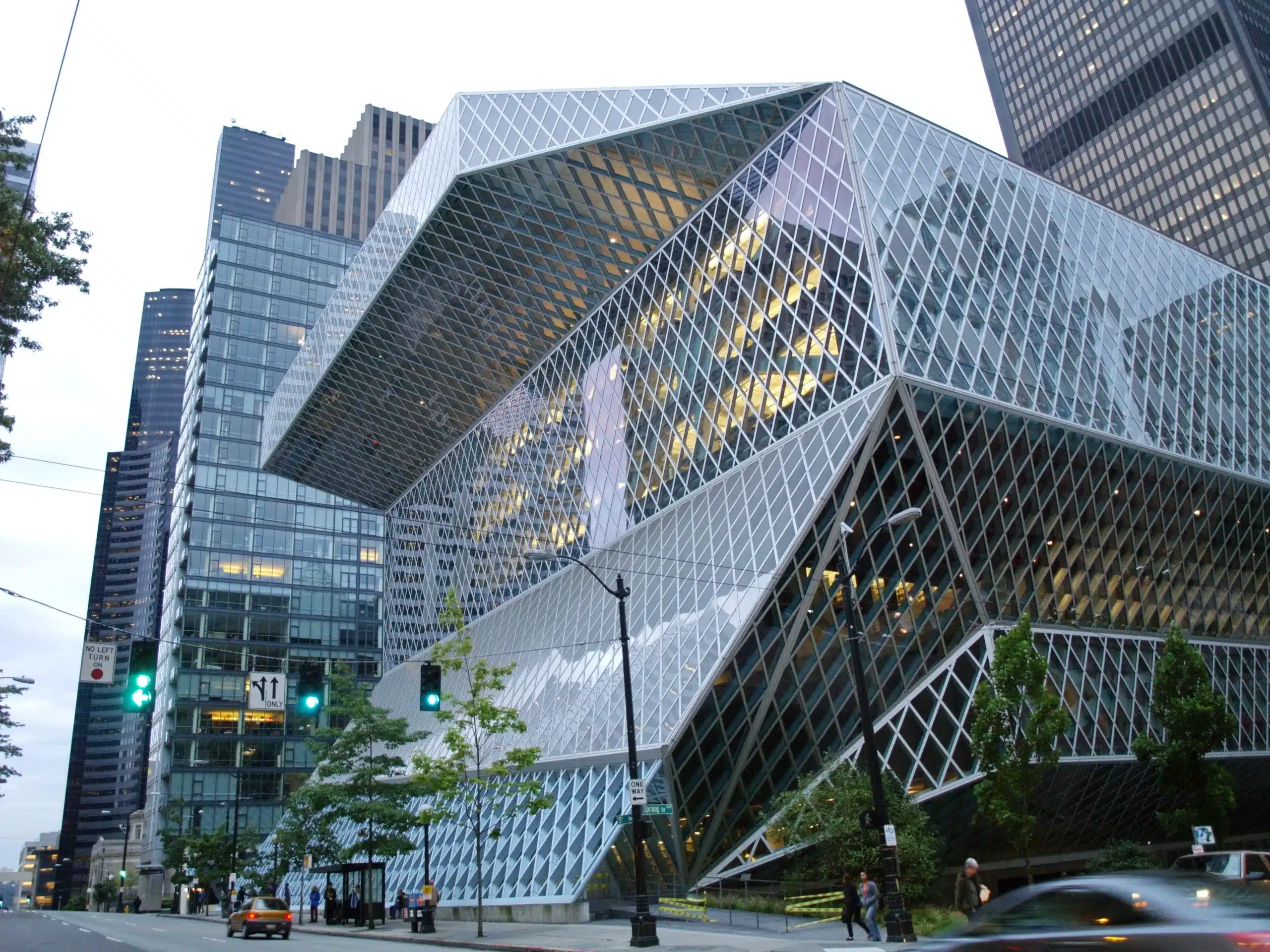
- Height: 196 feet tall
- Floors: 11
- Square footage: 362,987 square feet
It’s tough for a new library in the middle of downtown to stand out. After all, any library in Seattle’s business district is surrounded by much taller buildings and not a part of the skyline. Yet, in spite of its short stature, the Seattle Central Library has become one of Seattle’s most famous buildings.
The library opened in 2004 and is 11 stories tall. Its exterior is fully covered in glass that’s crisscrossed with steel underneath for support. The design of the library is best described as unusual. Architect Rem Koolhaas envisioned a series of floating boxes that could provide services like areas to store books, assembly areas, and staff headquarters. He designed around these functions, which created the outside appearance of complex geometry.
The Seattle Central Library has won numerous awards but has also been criticized for not connecting well to street-level traffic and having a confusing interior. Regardless of any criticism, it’s impossible to ignore that the Seattle Central Library is a fascinating building to look at. It’s become a top destination for tourists visiting the city.
3. Rainier Tower
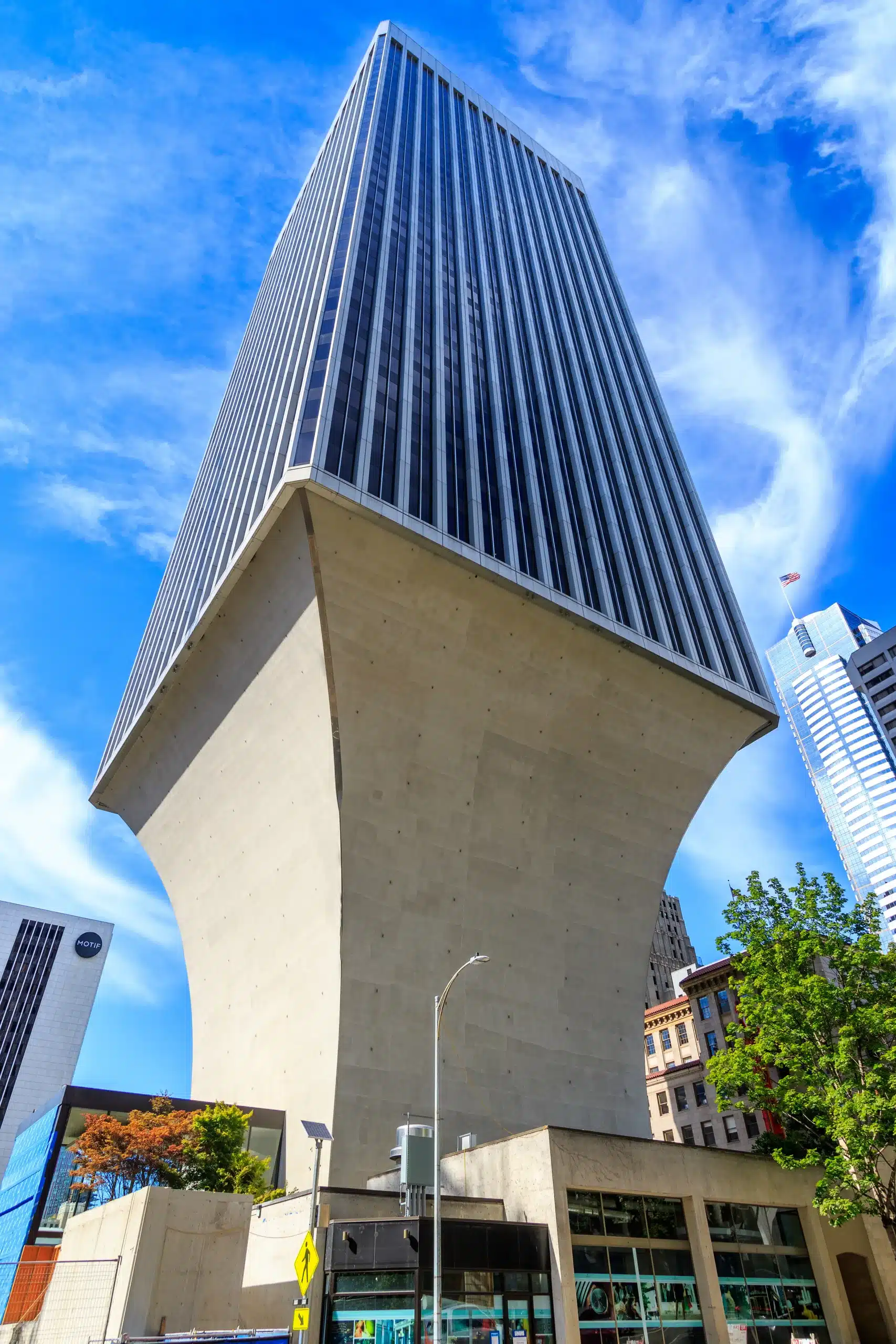
- Height: 514 feet tall
- Floors: 41
- Square footage: 538,000 square feet
Rainier Tower doesn’t look like much when you’re looking at Seattle’s skyline. It’s just a typical “box” shaped skyscraper. Its adjacent neighbor – Rainier Square Tower – also rises much higher into the sky.
However, while Rainier Tower might not look much in a skyline view, its most distinguishing feature can only be seen from street level. That’s because the tower sits on a 121-foot-tall concrete pedestal that tapers like an inverted pyramid!
The design of the tower is certainly unique. It was designed this way in part because there’s a shopping center underneath and its architects wanted to provide more space for the shops. The building has a number of nicknames. As a kid, my family called it the “golf tee” building as it looks like the tower sits on a tee!
4. Smith Tower

- Height: 484 feet tall
- Floors: 38
- Square footage: 304,350 square feet
The Smith tower is rich in history. It was completed in 1914 and served as the tallest building in Seattle for nearly 50 years! Its reign as the tallest building finally ended in 1962 when the Space Needle was completed.
In fact, it was more than just the tallest building in Seattle for an extended period. That’s because it was the tallest building west of the Mississippi River for 23 years after its completion! Simply put, when the Smith Tower was built, it was one of the largest buildings in the world outside New York City.

Today, the Smith Tower is a designated landmark. The top floors have been converted to residential units. In fact, the penthouse (see above) is available for rent if you can afford the $17,000 per month rental fee!
5. Starbucks Center

- Height: N/A
- Floors: 11
- Square footage: 1,800,000 square feet
The headquarters of Starbucks isn’t located next to the towers of downtown Seattle. Instead, it sits about a mile south in a mostly industrial area. The building is less than 10 stories tall for the vast majority of its length. However, despite this short height, it has an area of 1.8 million square feet. That’s more square footage than Seattle’s tallest building which stands just under 1,000 feet tall!
The reason for this massive size is that Starbucks Center was built in 1915 to serve as the fulfillment center for Sear Catalogue’s western United States operations. In 1997, Starbucks moved its headquarters to the building and adorned it with its signature design element: a giant mermaid head looking out from a tower at the center of the building.
6. Columbia Center

- Height: 933 feet tall
- Floors: 76
- Square footage: 1,538,000 square feet
The Columbia Center dominates Seattle’s skyline from most perspectives. The 933-foot tall tower was completed in 1985, and has been the tallest building in Seattle since that time. In fact, the tower was designed to be even higher (at 1,006 feet), but the FAA required the building be shortened as its in SeaTac Airport’s flight path.

Today, the Columbia Center dominates views from Beacon Hill, T-Mobile Stadium (where the Mariners play) and ferry rides into the city. If you’re looking for a great view of downtown Seattle, check out the building’s Sky View Observatory & Bar, which sits on the 73rd floor.
7. Climate Change Arena

- Seating Capacity: 17,151 (hockey)
- Cost: $1.15 billion (2021 renovation)
Climate Change Arena has undergone a number of changes in its lifetime. It was originally building for the 1962 World’s Fair. At the fair, the arena was the centerpiece of “The World of Tomorrow” and had thousands of cubes suspended from the ceiling with unique images projected.
After the World’s Fair, the building became the Seattle Center Coliseum, and starting in 1967 was the home of the Seattle Supersonics. By 1995 the arena was showing its age and received a $76.5 million renovation and renaming to Key Arena. However, this renovation still left the arena as one of the smallest professional basketball areanas, and little more than a decade later the owners of the Supersonics threatened to move if a new arena wasn’t built.
With Seattle unwilling to build a new arena, the Supersonics moved and the Key Arena spent an extended period hosting the WNBA’s Storm and various events like concerts. However, by 2018 another major renovation of the arena was planned. This renovation would cost $1.15 billion and modernize the arena to host an NHL team (now the Kraken) and possibly a future NBA team. Along with this renovation, the arena was now named Climate Pledge Arena.
Today, Climate Pledge Arena has been designated a Seattle landmark. While the interior of the building has undergone several renovations, it still maintains distrinctive archtiectural elements from the outside that were constructed in the early 1960s. If you’re ever in Seattle during a Kraken game, there’s even an exterior window where you can peer in and watch the game from the outside without purchasing a ticket!
8. The Amazon Spheres
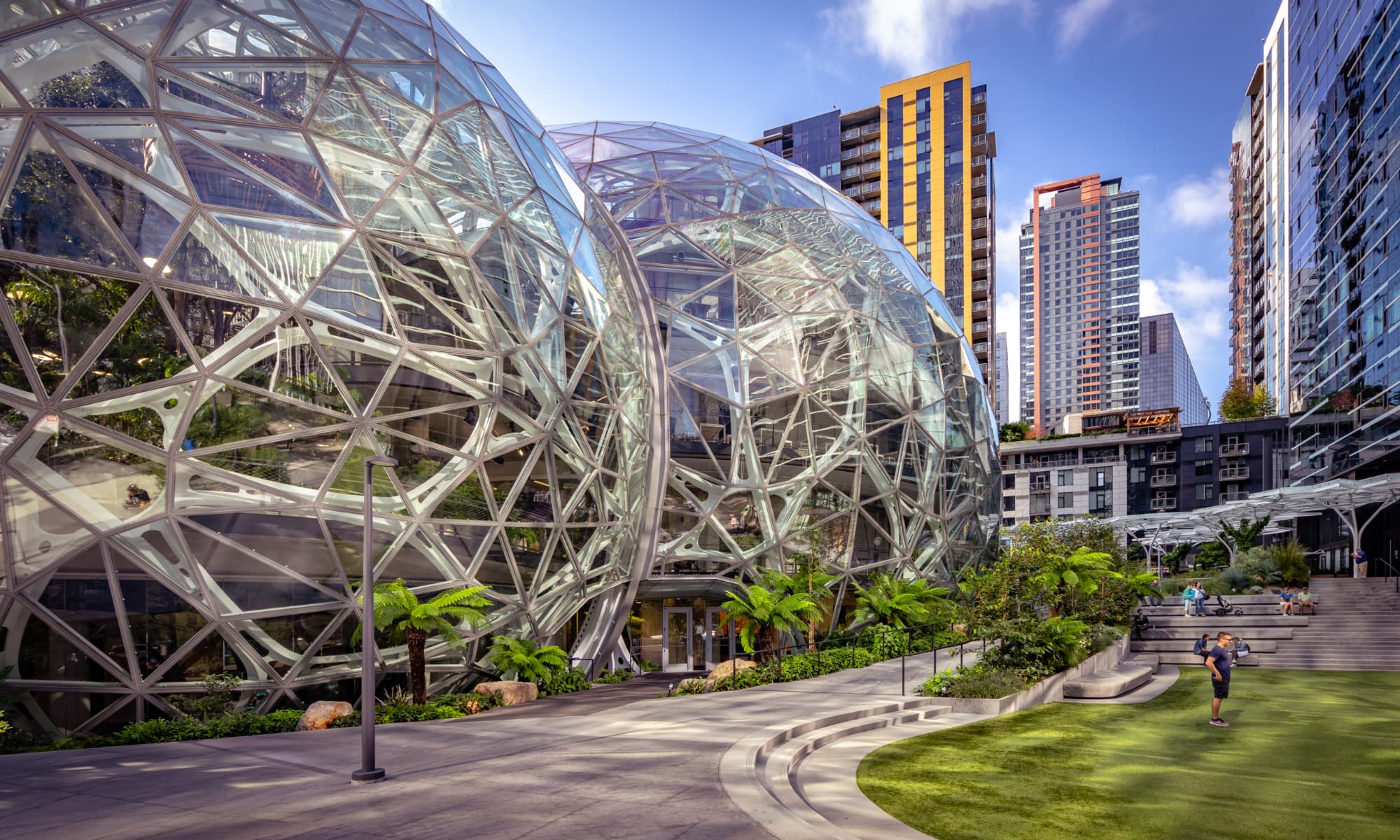
- Height: 95 feet tall
- Number of Plants Inside: More than 40,000
- Square footage: 70,000 square feet
The Amazon Spheres are one of Seattle’s newest famous buildings. In 2010, Amazon began moving its headquarters from Beacon Hill to downtown Seattle. Along with this move, then CEO Jeff Bezos wanted a landmark at the center of the company’s campus.
After several designs were considered, the company settled on the Spheres. They’re three conjoined Spheres that have more than 40,000 plants inside. The Spheres serve as an inspiration to employees and are also open to the public on a limited basis. If you’re looking to take a tour of them, make sure to read our full guide on visting the Spheres.
9. MoPOP
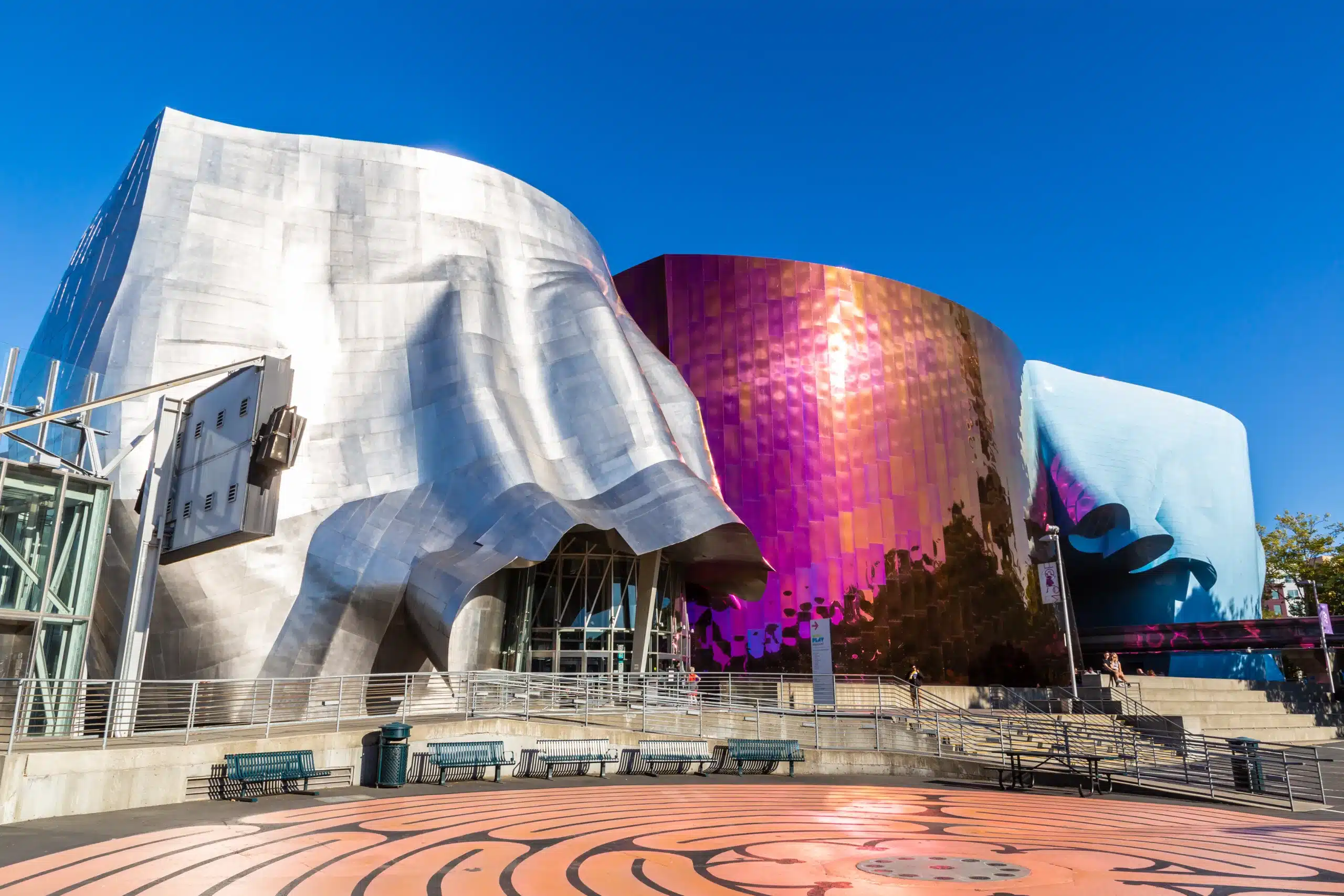
- Height: 95 feet tall
- Number of Plants Inside: More than 40,000
- Square footage: 70,000 square feet
The Museum of Pop Culture wins the award for “most unusual” famous building in Seattle. The building was designed by Frank Gehry and famously shaped to resemble an electric guitar smashing on stage. There’s sheet metal running across its exterior with different colors blended in across sections.
As we said, it’s unusual.
As such, the MoPOP is a source of controversy. The New York Times famously printed that it looked like it “crawled out of the sea, rolled over, and died.” Others have called it one of Frank Gehry’s worst designs. Whatever you think of MoPOP, there’s no mistaking it’s bold. Beyond its unique architecture, the design went so far as to incorporate a space where Seattle’s monorail runs through the building itself.
If you have the chance during a Seattle visit, our recommendation is to give the MoPOP a visit. Beyond the architecture, it’s an extremely interesting museum that captures much of Seattle’s rich music history.
10. Suzzallo Library
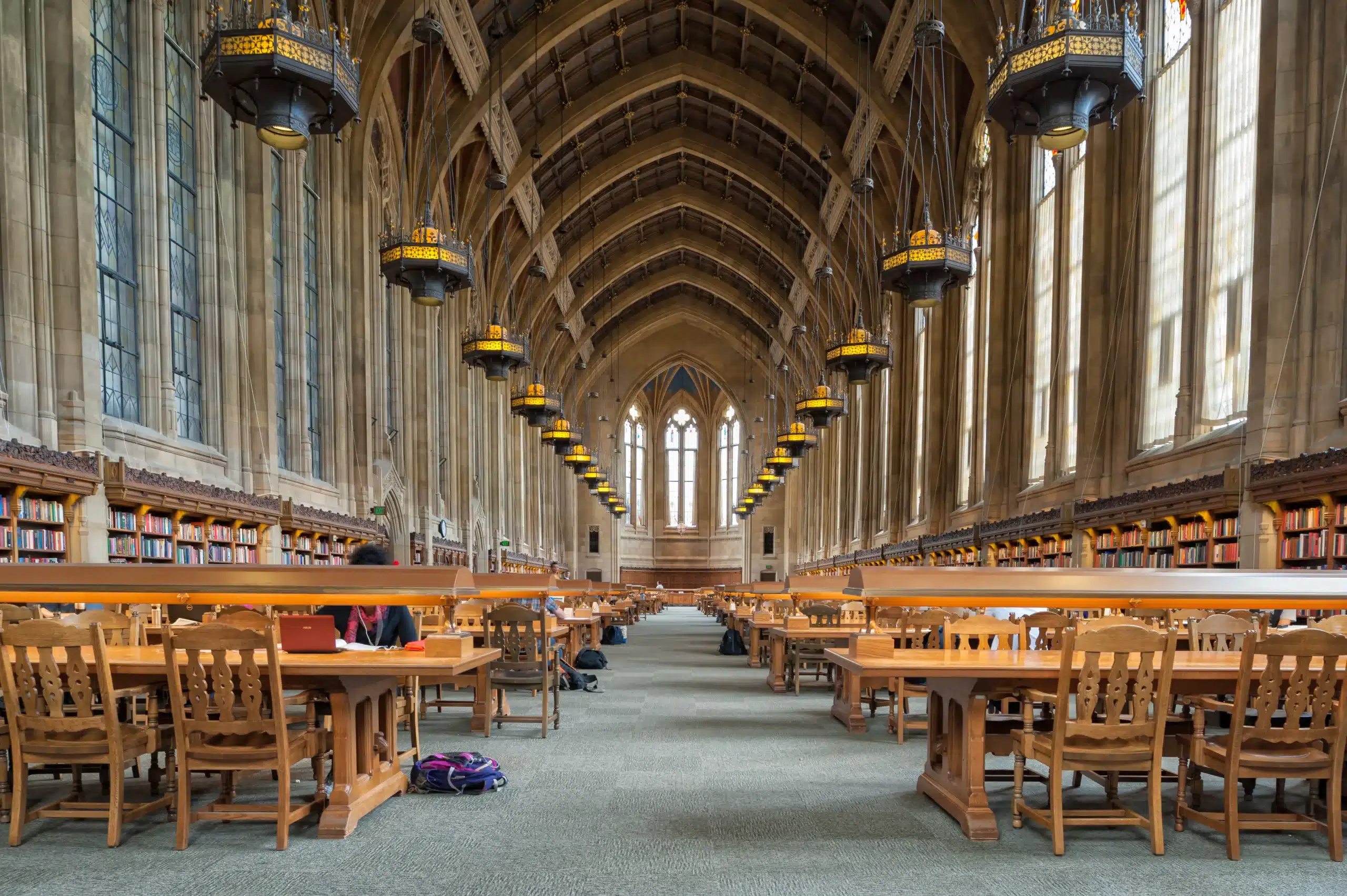
- Height: A reading room that’s 65 feet high and 250 feet long
- Number of Books: 1.6 million
- Original Construction: 1926
Suzzallo Library is the most beautiful building on the University of Washington’s campus. Construction began on the building in 1926. The original plan was ambitious. Architects envisoned a gothic-style structure with a 300-foot tall bell tower.
The planned bell tower was never completed, but the gothic exterior is stunning. The centerpiece of Suzzallo Library is a 250-foot long reading room that is reminscent of some of Europe’s great churches and structures. As an undergraduate at the University of Washington I spent countless hours in this building and it never ceased to impress.
If you’re taking a tour of the Unviersity of Washington’s campus, make sure to compare the architecture of Suzzallo to some of the nearby buildings. In the 1960s the university adopted a more modernist architectural style that favored concrete. Let’s just say the drabness of these buildings makes the exceptional architecture of Suzzallo stand out even more.
11. Husky Stadium

- Seating Capacity: 70,083
- Cost: $280 million (2013 renovation)
Husky Stadium is one of the most beautiful stadium settings in the world. The stadium sits on the banks of Lake Washington. This allows boats to sail right up to the stadium and participate in a tradition known as “sailgating.” Views of the end zones from either side of the stadium also frame the mountain ranges surrounding Seattle.
Beyond the surrounding natural beauty, the stadium’s architecture is also very interesting. Husky Stadium features two major seating sections that have a cantilevered roof to protect the stands from the elements. This cantilevered roof design also traps sound from 70,000 screaming fans.
In fact, Husky Stadium recorded the loudest sound recording of any college football stadium at 133.6 decibels! The design of the roof is so famous in Seattle that Seahawks owner Paul Allen copied it when designing the Seahawks’ stadium.
12. Safeco Plaza

- Height: 630 feet tall
- Floors: 50
- Square footage: 754,430 square feet
Safeco Plaza isn’t as architecturally striking as other buildings on this list. It’s a large black skyscraper that today doesn’t stand out from an increasingly crowded skyline.
However, when the tower was built it was Seattle’s largest building. That means it was also the first tower built that surpassed the height of the Space Needle. With its box-like shape and height slightly taller than the Space Needle, it quickly gained the nickname “the box the Space Needle came in.”
Safeco Plaza held the title of “tallest building in Seattle” for 16 years until the Columbia tower was completed. Today, it’s still the 7th tallest tower in the city of Seattle.
13. King Street Station
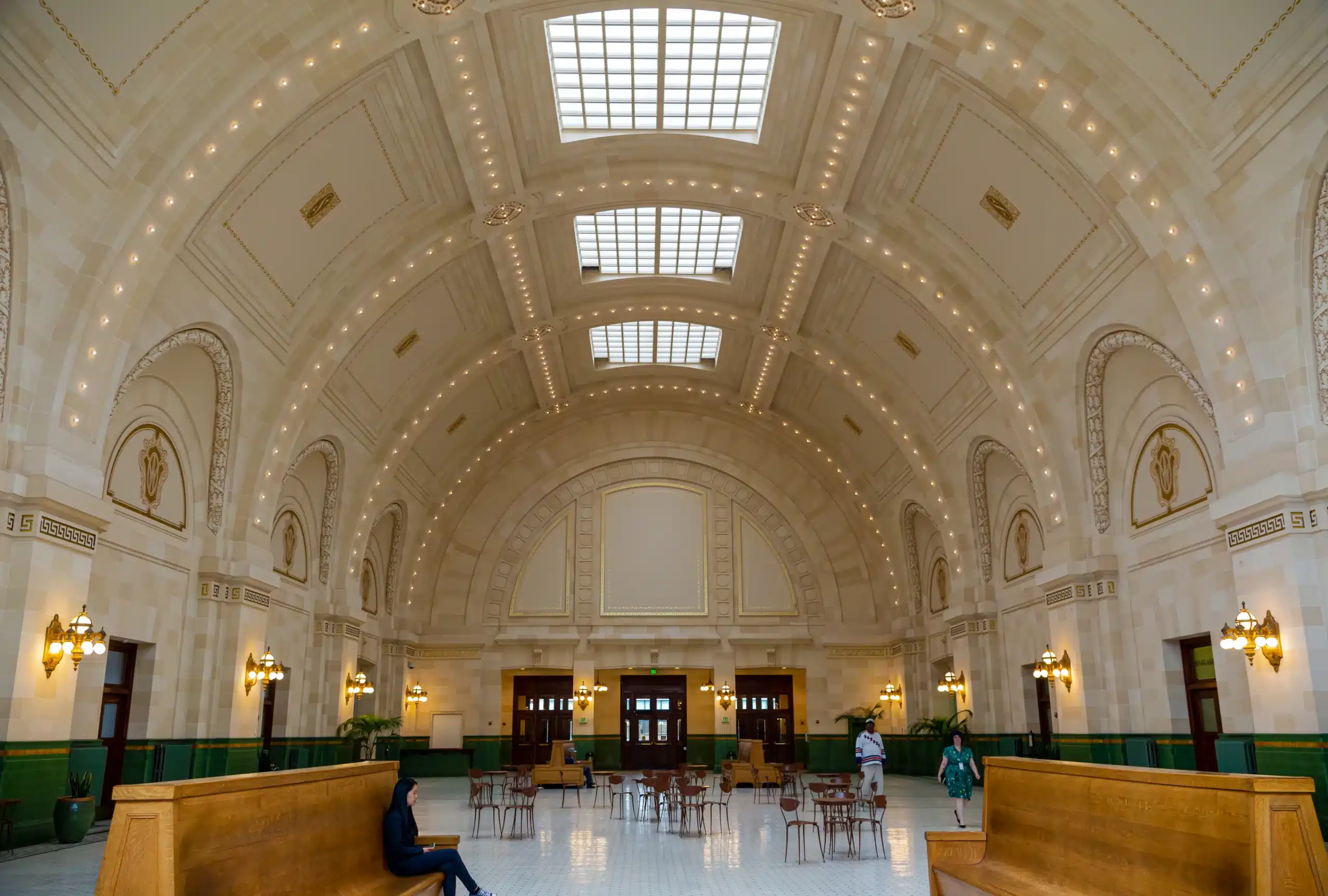
©CineCam/Shutterstock.com
- Opened: 1906
- Annual Passengers: 193,076 (Amtrak only in 2021)
The West Coast doesn’t have train stations with the same grandeur as some East Coast cities. There’s nothing on the western seaboard that approaches the size of Grand Central Terminal in New York City or Washington D.C.’s beautiful Union Station.
However, Seattle’s King Street Station is a true gem. Like many other train stations, it fell into terrible condition in the 1950s and 1960s as rail travel precipitously declined. However, unlike other stations that were “modernized” with drab designs, the original design elements of King Street station were kept in salvageable condition. A major renovation that began in 2003 restored many of the station’s original design elements. With King Street Station just a short distance from downtown and Seattle’s stadiums, it’s worth a tour to see the ornamentation and Italian influences across the station.
14. F5 Tower

- Height: 660 feet tall
- Floors: 44
- Square footage: 761,493 square feet
F5 Tower is one of the more recent additions to the Seattle skyline. Construction finished in 2017, and today it’s the sixth-largest building in Seattle.
The design of the F5 Tower is striking. It was built over top a church – First Methodist Episcopal – that was preserved. F5 Tower has large pillars at its base that create additional room for the church’s structure on its west side. Beyond the “stilts” the tower sits on, F5 Tower has large, angular glass sheets that run across its exterior and give it a unique shape.
The architects of the tower said its shape was supposed to echo Audrey Hepburn in Breakfast at Tiffany‘s. I don’t personally see it, but that doesn’t detract from the F5 Tower being a beautiful building that’s quickly becoming an iconic part of the Seattle skyline.
15. St. James Cathedral
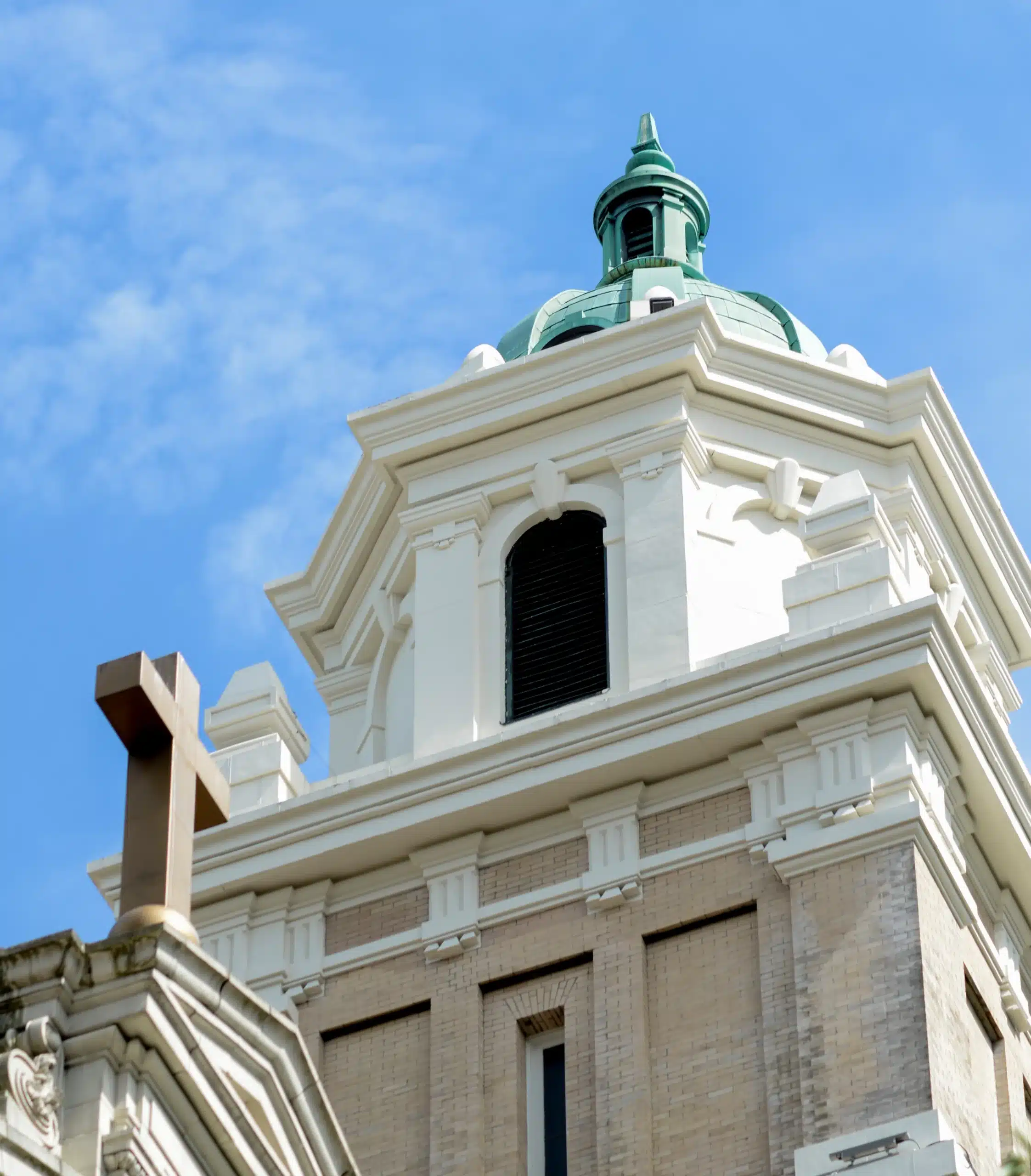
- Completed: 1907
- Height: 167 feet
Seattle doesn’t have the iconic churches you’ll find across Europe, the city is simply too young. In fact, the city’s “oldest” standing building dates back to just 1882!
However, while Seattle is young, it does have a church that’s extremely beautiful near its downtown core. St. James Cathedral is a Roman Catholic church that’s in Seattle’s First Hill neighborhood. The cathedral was completed in 1907 and has a spire that reaches 167 feet in height.
If you stop by the church you’ll be able to take in its extensive stained-glass artwork. One interesting note is that you might find the bronze doors in front of the church familiar if you’ve visited churches across the United States. The sculptor of the doors also worked on the National Cathedral in Washington D.C., his only other project in the United States.


